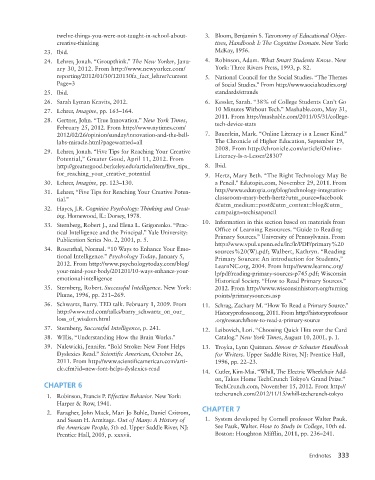Page 370 - Keys to College Success
P. 370
twelve-things-you-were-not-taught-in-school-about- 3. Bloom, Benjamin S. Taxonomy of Educational Objec-
creative-thinking tives, Handbook I: The Cognitive Domain. New York:
23. Ibid. McKay, 1956.
24. Lehrer, Jonah. “Groupthink.” The New Yorker, Janu- 4. Robinson, Adam. What Smart Students Know. New
ary 30, 2012. From http://www.newyorker.com/ York: Three Rivers Press, 1993, p. 82.
reporting/2012/01/30/120130fa_fact_lehrer?current 5. National Council for the Social Studies. “The Themes
Page=3 of Social Studies.” From http://www.socialstudies.org/
25. Ibid. standards/strands
26. Sarah Lyman Kravits, 2012. 6. Kessler, Sarah. “38% of College Students Can’t Go
27. Lehrer, Imagine, pp. 163–164. 10 Minutes Without Tech.” Mashable.com, May 31,
2011. From http://mashable.com/2011/05/31/college-
28. Gertner, John. “True Innovation.” New York Times, tech-device-stats
February 25, 2012. From http://www.nytimes.com/
2012/02/26/opinion/sunday/innovation-and-the-bell- 7. Bauerlein, Mark. “Online Literacy is a Lesser Kind.”
labs-miracle.html?pagewanted=all The Chronicle of Higher Education, September 19,
2008. From http://chronicle.com/article/Online-
29. Lehrer, Jonah. “Five Tips for Reaching Your Creative
Potential,” Greater Good, April 11, 2012. From Literacy-Is-a-Lesser/28307
http://greatergood.berkeley.edu/article/item/five_tips_ 8. Ibid.
for_reaching_your_creative_potential 9. Hertz, Mary Beth. “The Right Technology May Be
30. Lehrer, Imagine, pp. 123–130. a Pencil.” Edutopia.com, November 29, 2011. From
31. Lehrer, “Five Tips for Reaching Your Creative Poten- http://www.edutopia.org/blog/technology-integration-
tial.” classroom-mary-beth-hertz?utm_ource=facebook
&utm_medium=post&utm_content=blog&utm_
32. Hayes, J.R. Cognitive Psychology: Thinking and Creat- campaign=techisapencil
ing. Homewood, IL: Dorsey, 1978.
10. Information in this section based on materials from
33. Sternberg, Robert J., and Elena L. Grigorenko. “Prac-
tical Intelligence and the Principal.” Yale University: Office of Learning Resources. “Guide to Reading
Publication Series No. 2, 2001, p. 5. Primary Sources.” University of Pennsylvania. From
http://www.vpul.upenn.edu/lrc/lr/PDF/primary%20
34. Rosenthal, Normal. “10 Ways to Enhance Your Emo- sources%20(W).pdf; Walbert, Kathryn. “Reading
tional Intelligence.” Psychology Today, January 5, Primary Sources: An introduction for Students,”
2012. From http://www.psychologytoday.com/blog/ LearnNC.org, 2004. From http://www.learnnc.org/
your-mind-your-body/201201/10-ways-enhance-your- lp/pdf/reading-primary-sources-p745.pdf; Wisconsin
emotional-intelligence Historical Society. “How to Read Primary Sources.”
35. Sternberg, Robert. Successful Intelligence. New York: 2012. From http://www.wisconsinhistory.org/turning
Plume, 1996, pp. 251–269. points/primarysources.asp
36. Schwartz, Barry. TED talk. February 1, 2009. From 11. Schrag, Zachary M. “How To Read a Primary Source.”
http://www.ted.com/talks/barry_schwartz_on_our_ Historyprofessor.org, 2011. From http://historyprofessor
loss_of_wisdom.html .org/research/how-to-read-a-primary-source
37. Sternberg, Successful Intelligence, p. 241. 12. Leibovich, Lori. “Choosing Quick Hits over the Card
38. Willis, “Understanding How the Brain Works.” Catalog.” New York Times, August 10, 2001, p. 1.
39. Nalewicki, Jennifer. “Bold Stroke: New Font Helps 13. Troyka, Lynn Quitman. Simon & Schuster Handbook
Dyslexics Read.” Scientific American, October 26, for Writers. Upper Saddle River, NJ: Prentice Hall,
2011. From http://www.scientificamerican.com/arti- 1996, pp. 22–23.
cle.cfm?id=new-font-helps-dyslexics-read
14. Cutler, Kim-Mai. “Whill, The Electric Wheelchair Add-
on, Takes Home TechCrunch Tokyo’s Grand Prize.”
CHAPTER 6 TechCrunch.com, November 15, 2012. From http://
1. Robinson, Francis P. Effective Behavior. New York: techcrunch.com/2012/11/15/whill-techcrunch-tokyo
Harper & Row, 1941.
2. Faragher, John Mack, Mari Jo Buhle, Daniel Czitrom, CHAPTER 7
and Susan H. Armitage. Out of Many: A History of 1. System developed by Cornell professor Walter Pauk.
the American People, 5th ed. Upper Saddle River, NJ: See Pauk, Walter. How to Study in College, 10th ed.
Prentice Hall, 2005, p. xxxvii. Boston: Houghton Mifflin, 2011, pp. 236–241.
Endnotes 333

